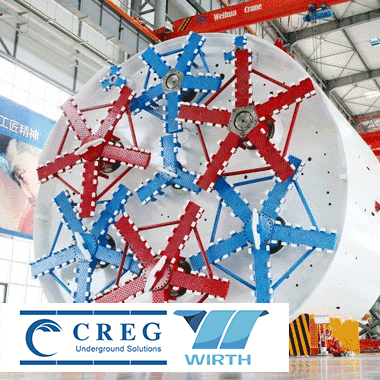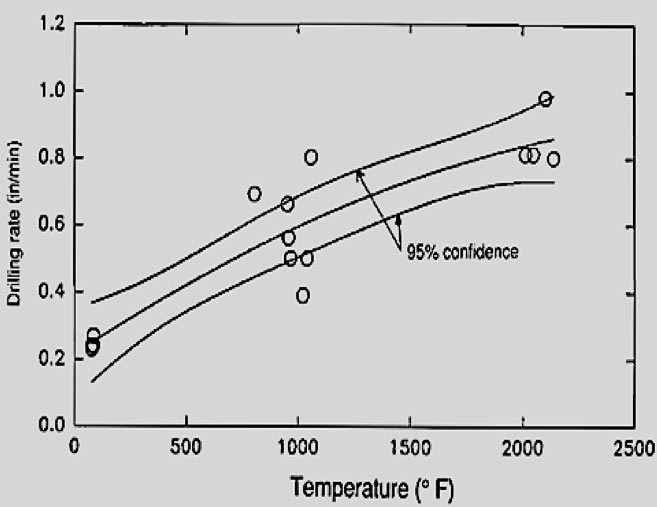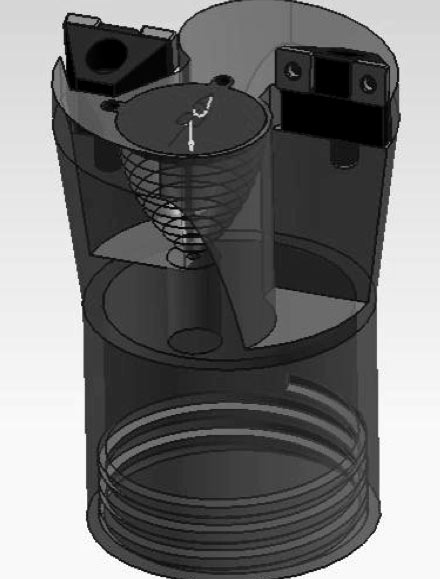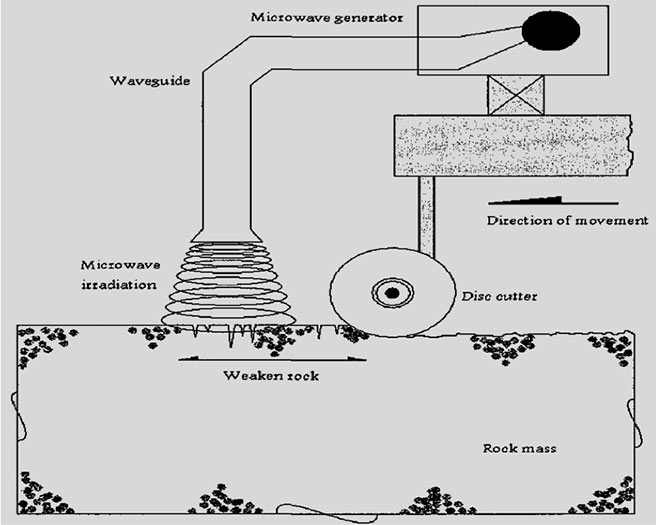Microwave-assisted hard rock excavation 25 Jan 2018
Using microwave technology to assist with the excavation of hard rock has been considered for some time. A review of experiments and studies to date provides a platform on which to base possible future research and development of the concept.
Rock drilling and cutting technology has evolved quickly in the last century, but excavation of very hard rock still presents challenges such as low penetration rate and high wear rate of rock bits and cutting tools. In order to address this, microwave assisted rock breakage has recently been drawing further attention. Studies show that microwave treatment decreases the strength and abrasivity of rocks, and preliminary experiments indicate that microwave treatment improves drilling efficiency and extends the service life of cutting tools.

Fig 1. Local failures at the point of loading after microwaving (left) and cracking after microwave exposure (right)(8)
Microwaves occupy a part of the electromagnetic spectrum where wavelengths vary between 1mm and 1m with a frequency of 0.3GHz to 300GHz. A microwave of 2.45GHz is the most commonly used1 and corresponds to a wavelength of 12.2cm and an energy of 1.02 x 10-5 eV.
Materials are classified as conductors, which reflect microwaves, insulators through which microwaves pass with no effect, and absorbers (dielectric materials) which absorb a part of the microwaves, induce molecular motion by migration of ionic species and/or rotation of dipolar species, and produce heat.
Minerals and rocks are dielectric materials with dielectric constants and loss factors depending on mineralogy and petrography. Grain size, mixture percentage, water content, ambient temperature and the applied microwave frequency influence the final dielectric properties of the rock.
The differential thermal expansion of minerals in rocks leads to internal stresses that cause micro-cracks within the rocks and decrease rock strength. Investigations of the effect of microwaves on rock strength have informed possible application of microwave assisted (MWA) rock breakage.
Studies completed in the early 2000s(6,7,8) found that andesite samples treated with microwaves completely melted after being exposed to 1,350W of power at a frequency of 2.45GHz for 10 minutes in a multimode cavity. X-ray diffraction analyses indicated that the basic chemical composition of the andesite remained the same without any losses in weight, but the structure of andesite turned amorphous after melting.

Fig 5. a) Norite cracked after microwave treatment for 65 seconds at 5kW, b) Surface spalling of Basalt 1 after microwave treatment for 35 seconds at 3kW, c) Basalt 2 melted after microwave treatment for 120 seconds at 3kW13
Basalt samples exposed to microwave irradiation of 750W in a multimode cavity for exposures of180 and 320 seconds caused the sample to spall and chip off locally under a point load test with visible macro-cracking and splitting observed for the longest exposure duration (Fig 1 ) and a reduction in the strength of the rock with increased time exposure (Fig 2 ).
In one study, hard-rock core specimens exposed to microwave energy of 800W, 1,250W and 3,000W, with exposure lasting from 0 to 240 seconds, exhibited a decrease about 30% in UCS values of almost all samples after treatment. The tensile strength of some samples reduced significantly and with a reduction of up to 80% observed for basalt samples (Fig 3). The Cerchar abrasivity index of almost all samples showed a reduction of about 30%.(9)
For sandstone, granite and basalt treated in a 3kW microwave oven at 2.45GHz, one study determined that saturation with water enhanced the weakening in sandstone, but had little effect in granite and had negligible effect in basalt. (10)
For basalt, norite and granite samples exposed to microwave energy of 1.2kW, 3kW and 5kW for 10, 65 and 120 seconds in a multimode cavity there was a significant reduction of tensile strength (Fig 4 ) and a slight reduction in the UCS of the rock samples (the specimen size influences the results of the tests). Moreover, the longer the exposure and the higher the microwave power, the higher the reduction rate of the mechanical properties of the rocks. (11)
Semi-circular basalt specimens with 50mm diameter and 15mm thickness were exposed to microwave radiations for 5 to 30 seconds at power levels of 1kW to 5kW to determine the influence of microwave treatment on the fracture toughness of basalt specimens(12). The study revealed that both power level and exposure duration to microwave illumination lead to fracture toughness reduction and an increase of fracture density. Applying higher powers in shorter durations caused more fracture density and fracture toughness reduction.
Comprehensive laboratory tests investigated the influence of microwave radiation on temperature profiles and strength reduction in hard rocks such as norite, granite and basalt(13). The test results indicated that tensile and uniaxial compressive strengths were reduced with increasing exposure time and power level. The size of the specimen influenced the heating rate with smaller disc-shaped specimens heating more rapidly than larger cylindrical samples. Some norite and granite samples cracked (Fig 5a), and some basalt specimens showed surface spalling, bursting or melting (Fig 5b,c).
MWA rock drilling
There are very limited studies on MWA rock drilling. MWA drilling experiments performed on granodiorite and basalt in pilot scale used a high-power microwave generator providing a continuous power output varying from 0kW to 25kW at a frequency of 2.45GHz. (14) MWA rotary drag bit cutting demonstrated a dramatic increment in the penetration rate compared to untreated rock. Penetration rates in granodiorite at 1,093oC (2,000oF) were in excess of three times the rates at 25oC (77oF) (Fig 6 ). Since bit temperatures remained low, no destruction of the carbide-to-steel brazing occurred, and all of the bits remained in good condition. A cost comparison determined the cost to mine one short tonne of hard rock to be $5.28 for the microwave-assisted method and $8.00 for the unassisted method.
An MWA hydraulic rotary drill machine designed and patented by a research team McGill University combined microwave energy and mechanical tools for breaking hard rocks.(15,16) The drilling machine was set up, but the rock bit including the microwave antenna was in the design stage (Fig 7).
One microwave drill bit (Fig 8) has evenly distributed microwave concentrators in each blade of the bit. (17) Electricity is transferred to the microwave concentrators to produce microwave radiation. Drilling tests showed that the efficiency of the microwave drill bit was two to three times of the standard bit. A power supply system for MWA drilling has also been designed.(18)
MWA rock cutting
A method of MWA hard-rock cutting has been patented and a basic design of microwave treatment of a rock block while cutting has been developed (Fig 9) (19). The application of the method has not been performed. Additionally, a schematic design of a MWA TBM cutterhead was created where rectangular microwave antennas are placed on the cutterhead in a way to cover the whole face of the tunnel (Fig 10).(11)
A field simulation with an open-ended horn waveguide in a closed cavity investigated the potential impact of microwave energy used in underground or surface excavations.(13) An artificial block of basalts was created by stacking 12 x 2cm-thick slabs and was exposed to microwaves at 3kW power for 60 or 120 seconds (Fig 11). The heating rate on the surface of the specimens linearly decreased with distance between the sample and the microwave antenna, regardless of microwave power level and exposure time. Temperature decreased exponentially with depth into the sample. The measured penetration depth for dry and wet basalts was approximately 5cm, which matched the calculated penetration depth (Fig 12). The highest macro-crack density in the topmost slab was observed when a dry basalt sample was irradiated for 120 seconds at a distance of 3cm from the antenna (Fig 13). The effect of water saturation on the temperature gradient was small due to the extremely low water permeability of basalt. Rock with higher permeability would require less microwave energy for mechanical destruction. Microwaves exiting an open-ended waveguide had high power intensity in the vicinity of the antenna, which diminished exponentially as it traveled through the medium.
The effects of high-power microwave irradiation on the cutting forces needed to cut granite with a conical pick were studied using 50cm x 50cm x 30cm granite blocks that were irradiated with 24kW at 2,450MHz frequency with an open-ended waveguide for a time of 30 seconds then cut by a linear cutting machine. Thirty seconds of microwave irradiation with 24kW power in a chessboard-like pattern led to a reduction of cutting forces by approximately 10% (Fig 14). Investigators stated that radiation times, spacing of radiation spots and adjustment of frequency could greatly increase the efficiency of microwave treatment preceding mechanical excavation.(20)
A small-scale MWA linear cutting machine has been designed and manufactured by the research team (Fig 15), and the design of the microwave system and its integration into the cutting machine continues. The rock block will be radiated just before cutting by a disc cutter (Fig 16). The microwave system will be designed as a single-mode cavity with 30kW of power at 2.45GHz.
Areas for further study
Microwave treatment weakens the strength of rockswith increasing microwave power and increasing exposure to microwave radiation increasing the weakening affect. While microwave treatment is a promising method for drilling and excavating hard rocks, further research is needed to determine its feasibility and economic impacts.
The rock types used in microwave treatment tests are limited, and tests should be extended to different rocks with different mineral contents and textural properties. Studies on the effect of water saturation on the microwave heating of rocks are also limited. Further research should be carried out on different rock types with different water contents.
There is only one study investigating the microwave radiation on the cuttability of granite. It indicates that microwave radiation decreased cutting forces, but the microwave radiation and cutting process were applied separately. Tests in which the microwave radiation process is applied just before cutting should be performed.
Most tests were carried out with multimode cavity applicators. In order to create a strong electromagnetic field, specially designed single-mode cavity applicators also should be used.
Most of the microwave generators used in the tests have a power of less than 3kW. Research has shown that applying higher powers in shorter durations decreased fracture toughness. Tests should be carried out on different rock with high power generators.
Further study is also required on the influence of the microwave treatment on the drillability of rocks to investigate indications that drilling rate increases with increased microwave power and increased exposure.
Author references
- Metaxas, A. C., Meredith, R. J. (1983). Industrial microwave heating. Short Run Press.
- Jacob, J., Chia, L.H.L., Boey, F.Y.C. (1995). Review of thermal and non-thermal interaction of microwave radiation with materials. Journal of Materials Science, 30(21), 5123-5327.
- Church, R.H., Webb, W.E., Salsman, J.B. (1988). Dielectric properties of low-lost minerals. United-States Department of the Interior and The Bureau of Mines, Report of investigation RI-9194.
- Santamarina, J. C. (1989). Rock excavation with microwaves, A literature review, in: Foundation engineering: current principles and practices proceedings, Evanston, Illinois, pp. 459-473.
- Peinsitt, T., Kuchar, F., Moser, P., Kargl, H., Restner, U., Sifferlinger, N. (2008). Microwave heating of rocks with different water content, in: Microwave Technology in Minerals Engineering (Microwave Technology 08), November 11-12, Cape Town, South Africa, 5p.
- Znamenackova, I., Lovas, M., Hajek, M., Jakabsky, S. (2003). Melting of andesite in a microwave oven. Journal of Mining and Metallurgy 39(3-4)B, 549 - 557.
- Satish, H. (2005). Exploring microwave assisted rock breakage for possible space mining applications. Masters of Engineering Thesis, Mechanical Engineering, McGill University.
- Satish, H., Ouellet, J., Raghavan, V., Radziszewski, P. (2006). Investigating microwave assisted rock breakage for possible space mining applications. Mining Technology 115(1), 34-40.
- Motlagh, P.N. (2009). An investigation on the influence of microwave energy on basic mechanical properties of hard rocks. MSc Thesis, Building, Civil and Environmental Engineering, Concordia University.
- Peinsitt, T., Kuchar, F., Hartlieb, P., Moser, P., Kargl, H., Restner, U., Sifferlinger, N.A. (2010). Microwave heating of dry and water saturated basalt, granite and sandstone. Int. J. Mining Miner. Eng. 2, 18-29.
- Hassani, F., Nekoovaght, P. (2011). The development of microwave assisted machineries to break hard rocks, in: Proceedings of the 28th ISARC, pp. 678–684.
- Nejati, H., Hassani, F., Radziszewski, P. (2012). Experimental Investigating of Fracture Toughness Reduction and Fracture Development in Basalt Specimens under Microwave Illumination, in: Earth and Space 2012, Proc. the 13th ASCE Aerospace Division Conf. on Engineering, Science, Construction, and Operations in Challenging Environments, California, April 15-18, pp. 325-334.
- Hassani, F., Nekoovaght, P.M., Gharib N. (2016). The influence of microwave irradiation on rocks for microwave assisted underground excavation. J. Rock Mech. Geotech. Eng. 8, 1-15.
- Lindroth, D.P., Berglund, W.R., Morrell, R.J., Blair, J.R. (1992). Microwave-assisted drilling in hard rock. Mining Engineering 44, 1159 - 1163.
- Hassani, F., Radziszewski, P., Ouellet, J. (2008). Microwave assisted drilling and its influence on rock breakage - A review, in: 5th Asian Rock Mechanics Symposium, 24-26 November, Tehran, Iran, pp. 97-104.
- Ouellet,J., Radziszewski, P., Raghavan, V., Satish, H., Hassani, F. (2013). Electromagnetic energy assisted drilling system and method. United States Patent No. US 8,550,82.
- Wang, Z., Wei, Z., Han, L. (2013). Microwave PDC Drill Bit. Advanced Materials Research 774-776, 1414-1417.
- Wei, Z., Wang, Z. (2014). The Power Supply System of the Microwave Assisted Rock Breaking Technology. Advanced Materials Research 962-965, 883-885.
- Lindroth, D.P., Berglund, W.R., Morrell, R.J, Blair, J.R. (1991). Microwave-assisted hard rock cutting. Unitet States Patent 5,003,144.
- Hartlieb, P., Grafe, B. (2017). Experimental study on microwave assisted hard rock cutting of granite. Berg und Hüttenmannische Monatshefte 162 (2), 77–81.
|
|
|
|
|
Add your comment
- Thank you for taking the time to share your thoughts and comments. You share in the wider tunnelling community, so please keep your comments smart and civil. Don't attack other readers personally, and keep your language professional.















